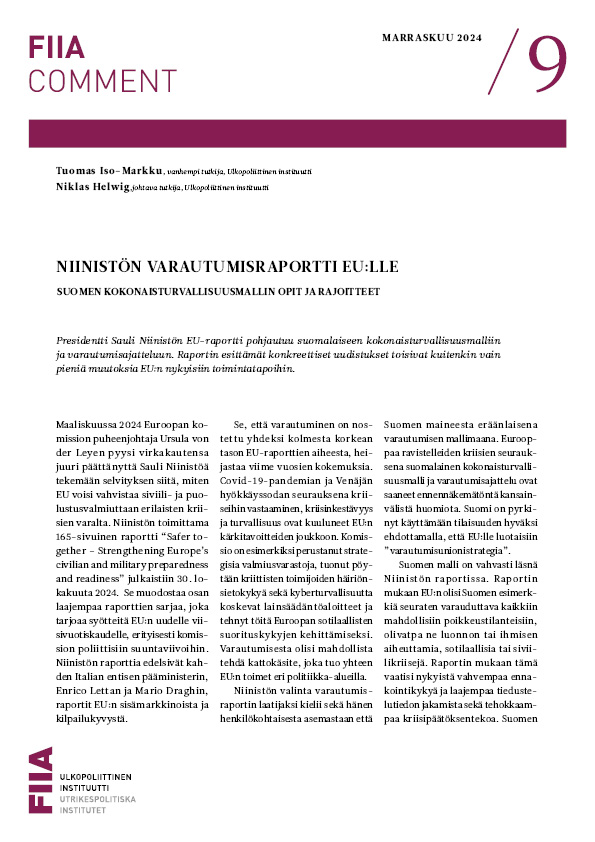The appointment of Donald Tusk and Federica Mogherini indicates a further shift in the dynamics of EU foreign policy-making towards the European Council. The two leaders will have to avoid rivalry and use their powers in Brussels to improve the EU’s international profile.
Last Saturday, European leaders appointed a successor to Catherine Ashton as High Representative of the Union. Many pundits hoped for a high-profile diplomatic powerhouse who could signal Europe’s strength to Russia and the world. To this end, they were disappointed with the appointment of Federica Mogherini, who is rather new in her current role as Italy’s foreign minister.
However, some overlooked the fact that the task of representing EU foreign policy was not placed solely in Mogherini’s hands, but also in those of Polish Prime Minister Donald Tusk. As President of the European Council, Tusk might adopt a much stronger international profile than his predecessor.
Tusk’s appointment indicates that member states are willing to upgrade the profile of the European Council President. The previous appointment of Herman Van Rompuy reflected the concerns of some EU leaders that a high-profile European Council President would outshine their activities on the world stage. Instead of appointing Tony Blair, they opted for a manager-type chairman from a small country.
The appointment of Tusk is different: this time they went for a long-serving prime minister from one of the largest member states, and someone who has the necessary network and standing to be accepted as a counterpart by other world leaders.
A strong foreign policy showing by Tusk would also reflect the European Council’s growing role in EU foreign policy-making. While the Lisbon Treaty tasks heads of state and government with giving strategic guidelines, in recent years their decisions have often delved into much greater detail. From the no-fly zone over Libya to sanctions against Russia, the political decisions were taken by EU leaders.
In stark contrast, Herman Van Rompuy never had the chance to adopt a strong foreign policy profile. He was preoccupied with forging a solution to the eurocrisis, and concerned himself with the smooth running of the machinery rather than with representing the EU in the world.
While the international environment was not conducive to Van Rompuy’s visibility in foreign policy issues, the current international situation might leave Tusk with no other choice but to get more involved. Following his appointment, he outlined the Ukraine crisis and EU-Russia relations as one of his three priorities – along with economic policies and the UK question. As Van Rompuy underlined: “On all international issues, Tusk and Mogherini will work closely together to defend European interests and values”.
Extending the European Council President’s remit in foreign policy matters appeals to EU leaders. Using the European Council President as a delegate rather than the High Representative offers the advantage that he is directly authorized and controlled by EU leaders and acts on their level.
Many diplomatic activities in recent months have been carried out between government leaders, rather than by foreign ministers, which reflects a general trend of the declining weight of foreign ministries. The Lisbon Treaty states that the European Council President represents the Common Foreign and Security Policy of the Union at his level. This is not just a ceremonial post. The European Council President represents the EU in the G7/8 and G20 meetings, together with the Commission President, as well as in other high-level dialogues with third states, such as EU-Russia summits.
An upgrade of the European Council President would have consequences for the dynamics of EU policy- making. While Ashton and Van Rompuy did not get in each other’s way, the two new leaders might vie for primacy over foreign policy.
Tusk will be formally higher in the hierarchy and steer the discussions of the highest political forum of the Union. Meanwhile, Mogherini will have control over the foreign policy toolbox and the European External Action Service’s (EEAS) resources. Moreover, she will be Vice-President of the Commission. It is now up to Commission President Jean-Claude Juncker to give Mogherini authority over a strong team of external relations Commissioners.
The two leaders have to avoid a split between the political dimension, led by the European Council, and the economic dimension in control of the European Commission. Creating the role of the ‘double-hatted’ High Representative was aimed at bringing the two realms of the EU’s external action closer together. If foreign policy representation shifts to the European Council, it once again risks being out of sync with the sectoral external work of the Commission.
Hence, it is important for Tusk and Mogherini to work in tandem. Tusk’s work can benefit from the input of the EEAS, which presides over the various geographical working groups in the Council and has a network of EU delegations around the world. Mogherini needs Tusk in order to commit member states to more strategic planning of EU foreign policy, which should be carried out under her guidance and by the EEAS. Critics should not be too quick to dismiss Mogherini’s qualifications out of hand. She has long experience in foreign policy that far exceeds her short time as Italy’s foreign minister.
If the eurocrisis remains on hold and the EU’s neighbourhood continues to be in turmoil, chances are we will see more international engagement by the European Council President. The shift will not pose a disadvantage, providing that Tusk’s work is well-coordinated with the rest of the EU foreign policy machinery. It would even offer the possibility to elevate the common foreign policy to a higher level and to make it more strategic. ‘Tuskerhini’ has the potential to become a strong foreign policy couple.








